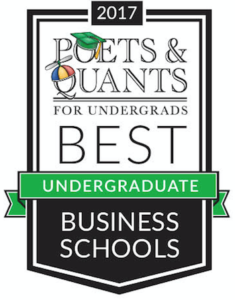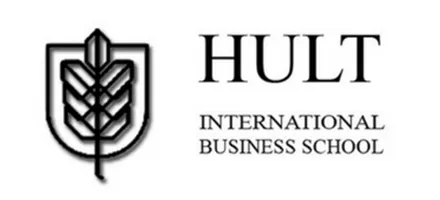How do you judge the value and quality of an undergraduate business education?
 In our second annual Poets&Quants’ ranking of the best undergraduate programs, we believe that the answer to that question comes down to three core issues: the quality of the raw talent coming through the door, what a school does with that talent over four years, and finally how the marketplace responds to the graduates coming off campus. In other words, what’s the quality of the incoming students, what is their view of the academic experience, and what career outcomes are achieved by the graduating class.
In our second annual Poets&Quants’ ranking of the best undergraduate programs, we believe that the answer to that question comes down to three core issues: the quality of the raw talent coming through the door, what a school does with that talent over four years, and finally how the marketplace responds to the graduates coming off campus. In other words, what’s the quality of the incoming students, what is their view of the academic experience, and what career outcomes are achieved by the graduating class.
And that is exactly the approach we take in what we sincerely believe is the best ranking of undergraduate programs currently available. This year, we rank 82 different business schools in the U.S., up significantly on the 50 ranked on our debut list last year.
In the world of undergraduate business education, there is only one other ranking that matters: U.S. News & World Report. The U.S. News list, however, is merely a subset of data from its overall university rankings. Largely a popularity contest, it is solely based on a poll of deans and senior faculty members, most of whom have little to no knowledge of the programs at rival schools. Asking deans to rate other schools is less a measure of a school’s reputation than it is a collection of prejudices partly based on the self-fulfilling prophecy of U.S. News’ own rankings.
SEVERAL DEANS ASKED US TO CREATE THE RANKING
In creating our 2017 ranking of undergraduate business schools, we invested considerable time and effort into creating a well-balanced approach that was both fair and thorough. We equally weight admission standards, the full academic experience, and employment outcomes. Those three components of a business program are critical factors of the quality of the educational experience. Excluding any one of them would result in a disingenuous effort to rank the very best schools.
We made a few tweaks to this year’s methodology, but nothing that would dramatically change our approach. To our survey of alumni in the Class of 2015, we added five new questions:
- Was your business school experience life-changing?
- Do you believe your business degree will assist you in climbing to a new socioeconomic status?
- How instrumental do you believe your business degree will be in reaching your dream career?
And a pair of questions that provide deeper insight into a school’s employment stats:
- Was your first job after graduating in your desired industry?
- Was your first job after graduating at your desired company?
Those two questions explore whether graduates “settled” for the jobs they got or really landed in industries and companies they specifically targeted for employment. That is an even higher standard for career outcomes (see Business Schools That Help You Get The Job You Really Want).
SLIGHT CHANGES TO THE 2017 METHODOLOGY
The only change in the methodology is the addition of these five questions and a slight change in the distribution of the weights used to account for the new questions. The questions requiring answers that range from one-to-ten went from 12 to 15, and the weight of those questions in only the alumni position of our methodology increased to 80% from 75%. We then reduced the weight of two existing questions about signature experiences and global immersions to 10% from 25%, giving the remaining 10% weight to the desired industry/companies questions.
These changes were made after we received feedback from the business schools. The methodology was originally developed not in isolation of but in collaboration with numerous business school deans and administrators. In fact, we only decided to create our ranking after being asked to do so by several business school deans, frustrated and deeply disappointed by earlier ranking efforts from other organizations.
This does not mean that every business school agrees with our approach. Several deans believed we should adjust starting salaries by cost-of-living in their geographic areas. But given the many far-flung locales where graduates choose to work, including many international locations, it was nearly impossible to devise a fair system of taking cost of living into account.
Besides, we discovered that contrary to popular belief, the power of a higher education brand often exceeds either geography or industry choice as a factor in compensation. Prestige also results in a degree that more effectively travels, having value far beyond a geographic region.
In the Washington, D.C., metro area, for example, Georgetown business grads pulled down total compensation of $78,413, more than $15,000 a year to start than business graduates of nearby University of Maryland. In New York, graduates from NYU’s Stern School outlearned those from Fordham’s Gabelli School by a similar margin: $78,349 versus $63,185, respectively. And undergrads from several midwestern schools–including Olin in St. Louis and Ross in Ann Arbor, Michigan–made more money to start than graduates from some schools in Boston and Silicon Valley. Ross grads in Michigan pulled down $77,246 in average total pay, while Olin grads in St. Louis earned $74,482. That compares with average pay of $66,770 at Santa Clara in the heart of Silicon Valley or $64,957 at Northeastern University in Bean Town.
ADMISSIONS STANDARDS (33.3%)
A vital factor in judging any higher education effort is the quality of the incoming students. After all, a tremendous amount of learning—both academic and social—occur as a result of the quality of your classmates. We agree with that old cliche about playing a sport with people who are equal or better than you. If you play with someone you can always beat, you’ll never reach a level of personal excellence.
We relied on three metrics to measure admissions: The average SAT scores for the latest entering class, given a 35% weight in the admissions category; the percentage of the entering class in 2016 who finished in the top 10% of their high school class, accounting for another 35% of the category; and finally the acceptance rate for the business school program, weighted at 30%.
In several instances, prospective students must pass two hurdles to get into a business school program: First, the university admissions standards and then the business school’s own admissions criteria. We used both acceptance rates to calculate the actual odds of admission for students entering a two-year business program in their junior year.
This data was gathered through a survey that was completed by 93 schools.
No study of undergraduate business programs would be complete without an assessment of the academic and extracurricular elements of the educational experience. So we sent surveys to alumni of each school to determine how satisfied they were on every level of that experience. Deans suggested that we choose alumni who had been away from their schools for two years. That would give them ample time to road test their education, to give an accurate assessment of how well prepared they were for the world of work.
Our survey asked a dozen core questions of graduates, each rated on a one-to-ten scale of satisfaction. For the full list of questions and the graded results, see “2017 Rankings Report Card: How Alums Grade Their Schools.” We also asked alumni whether they had a “significant experience,” defined as a major consulting project, thesis, or other program feature instrumental to their professional development, or a meaningful global immersion.
Schools that either declined to allow their Class of 2015 alumni to be surveyed or failed to meet a 10% threshold for the response rate were excluded from our ranking. Several fairly prominent schools failed to meet this threshold, including Ohio State’s Fisher College of Business and the University of Southern California’s Marshall School. Some 102 schools provided alumni contact info, while 93 schools completed the school survey. Of the 93 to complete the school survey, 82 also hit the minimum 10% participation rate. Of those 82 schools, 39,799 alums had the opportunity to complete the survey. Of those, 5,551 completed the survey for an overall response rate of 13.95%.
EMPLOYMENT OUTCOMES (33.3%)
Students who go to business school expect to get a job not long after graduating. Summer internships are a key way to open the door to a full-time job opportunity. So our employment outcomes category is based on three metrics: the percentage of the latest graduating class (the Class of 2016) to gain jobs within 90 days, weighted 50%; the average salary and bonus for the latest graduating class, adjusted by the percentage of graduates awarded a bonus, weighted 30%, and finally, the percentage of the Class of 2016 that had internships before their senior year, weighted at 20% (see What Business Majors Made This Year for our compensation data).
THE FINAL RANKING
The results of all three categories measured were then combined equally to determine an overall ranking. In each category, index scores were created to give credit to one school’s lead over others. We publish the numerical ranking with underlying index scores so that readers can determine how useful an actual ranking could be in relationship to the other schools on the list. It’s important to note that there are nearly 700 undergraduate business programs accredited by the AACSB. The 50 business schools singled out in our debut ranking are all extraordinary, each in the top seventh percentile of accredited schools.
Ultimately, this ranking and the mountains of data we are publishing is an effort to more fully inform prospective students and their parents to make the best educational decisions possible.











